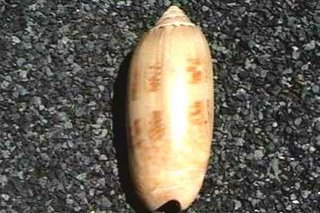



This shell (both shape and markings matching the listing in the book) is likely the Lettered Olive Oliva sayana, measuring 2-2.5" and commonly found from North Carolina through Florida and Gulf Coast.
Olive-Shaped - olives (Olividae)
Lettered Olive Oliva sayana (Ravenel)
Description: (2.5 inches) Smooth, shiny, cylindrical shell with a short spire. Narrow aperture extending almost length of shell, continuing around the bottom and ending in a notch on the other side. Suture V-cut and deep. Lower part of whorl just above the suture extends outward and then at a sharp shoulder drops into the suture. No operculum.
Color: Cream or grayish exterior with reddish brown zigzag markings.
Habitat: Lives in near-shore waters on shallow sand flats near inlets. Occasionally to commonly washed onto ocean beaches.
Range: North Carolina to Gulf states.
Notes: This species is named for its dark surface markings that resemble letters. A carnivore, it captures bivalves and small crustaceans with its foot and takes them below the sand surface to digest. Its presence is sometimes detected at very low tides by the trails it leaves when it crawls below the surface on semi-exposed sand flats. Females lay floating, round egg capsules that are often found in beach drift. Young are free swimming. Colonists and early native Americans made jewelry from these shells.
Brown Olive Oliva reticularis bifasciata (Kuster)
Description: (2.5 inches) Very similar to the lettered olive (above) except this species in North Carolina waters has (1) a less pointed spire, (2) a channel suture not deeply V-cut and (3) a lower whorl portion that runs almost directly into the connecting suture.
Color: Similar to lettered olive except in this shell (1) the pattern is lighter and more reticulated than zigzag, (2) the color is yellowish and (3) brown spots that run from the suture "thread" or "bleed" down the shell (in the lettered olive they do not).
Habitat: Lives in deep offshore waters. Found by divers near shipwrecks. Collected on sandy bottom near lions-paw scallops at 100-feet depth off Wrightsville Beach. From Wrightsville Beach to just above Cape Lookout, seems restricted to the edge of the continental shelf at about 300-foot depths.
Range: Cape Lookout, N.C. to West Indies
Source for both entries: Seashells of North Carolina, North Carolina Sea Grant College Program

No comments:
Post a Comment